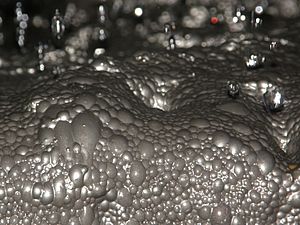Flotation facts for kids
Flotation is a cool way to separate tiny solid pieces from a liquid. Imagine you have a mixture, like sand in water, but the solid bits are super small. This process uses gas bubbles to pick up the solids and bring them to the surface.
Here's how it works: Gas bubbles are pumped into the bottom of a tank that holds the liquid and solid mix. As these bubbles rise through the liquid, the solid particles stick to their surfaces. When the bubbles reach the top, they form a thick foam. This foam is full of the solid particles you want to separate. Once the foam is formed, it can be easily scooped off, leaving the liquid much cleaner!
How Flotation is Used
Flotation is super important in many industries, especially in mining. It helps to separate valuable minerals from unwanted rock.
Separating Ores
One of the main uses of flotation is to get valuable sulfide ores out of rock. Ores are rocks that contain useful metals. Sulfide ores are minerals that have sulfur in them, like zinc sulfide.
When miners dig up ore, it's usually mixed with other useless rocks called gangue. Flotation helps to separate the good stuff (the sulfide minerals) from the gangue.
The Process in Mining
First, the ore is crushed into a fine powder and mixed with water to create a slurry (a thick liquid mixture). Then, a special chemical, like a detergent, is added. This chemical helps the valuable mineral particles to stick to the air bubbles.
Next, air is blown into the mixture, creating lots of bubbles. The sulfide minerals attach to these bubbles and float to the top, forming a mineral-rich foam. The unwanted gangue, which doesn't stick to the bubbles, sinks to the bottom of the tank.
The foam, full of the valuable minerals, is then collected. This process is used to get metals like zinc from its main ore, sphalerite (which is zinc sulfide). It's a very efficient way to get pure minerals from raw ore.


